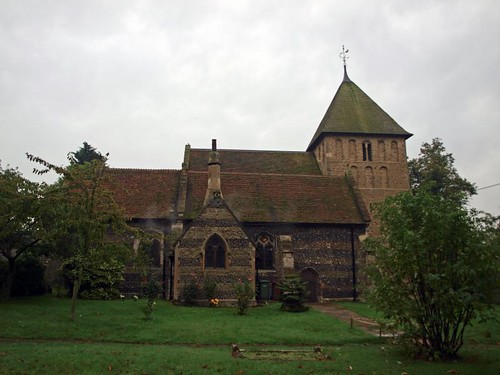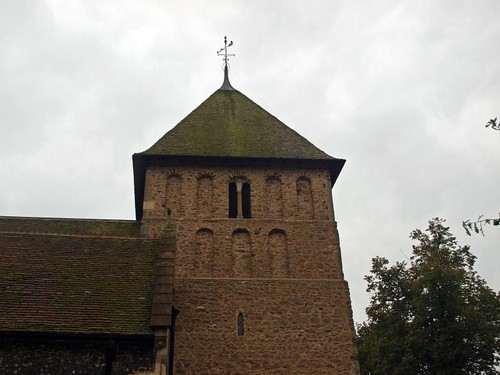St Mary the Virgin was open for morning Mass (which doesn't count as I didn't get inside - it's a bit rude to record an interior whilst the Eucharist is being celebrated!) but is usually locked no keyholder.
Best described as a fantastic Norman tower with a Gilbert Scott nave and chancel attached; the massive tower has, at the top, original blind arcading and is one of the finest of its kind in Essex.
ST MARY. The tower is one of the most important Early Norman monuments in the county, without buttresses, and with two tiers of large flat blank niches below the parapet. The middle one of the upper row on each side is pierced, has a colonnette set in and serves as a bell-opening. Pyramid roof. The whole is in its severity and clarity extremely impressive. Inside, the tower arch facing the nave is small and has the plainest imposts. N aisle, N chancel chapel and chancel are C14, see the two-bay aisle arcade (octagonal piers, double-chamfered arches) and several Dec windows (but the chancel E window belongs to Gilbert Scott’: restoration of 1843-44). - SCREEN. An early example of timber-screens in the county; first half C14. To l. and r. of the doorway only one partition, of four lights, with thin columns with shaftrings as mullions and intersected ogee-cusped arches. Plain straight moulded top-beam. - PLATE. Paten of 1684; Cup dated 1685. - MONUMENTS. Brass to Richard de Beltoun, c. 1340, demi-figure of priest. - Brass to a civilian, c. 1450. Both in the chancel floor.
CORRINGHAM. Thameshaven is its child, born almost yesterday, while Corringham has grown old for a thousand years. Much water has come down the Thames since this gracious place grew up among the lovely fields; and it has yet an old-world charm. We must love it for its group of old things, timber cottages and a 15th century inn keeping company with a glorious chestnut standing like a sentinel by the church. The tree is ancient but the church is older, for fragments of its walls were here before the Conqueror marched on London. The north aisle and the chapel are 14th century. The church tower is Norman and can have changed very little; it is immensely strong and has tiny windows but no buttresses, and its belfry has Norman arcading, with a roof like a hat too big for it. The tower arch has a keystone with a little head 800 years old. Among the treasures of this church so like a fortress are old bench-ends with carved panels; fragments of medieval glass with two angels and a dragon; two quaint old chests; and a fine oak screen with rich tracery, the work of a 14th century craftsman. The chapel has lost its brass portrait of Isabel Baud, who has been sleeping here 600 years, but the chancel has a civilian brass of 1460 and the brass portrait of one of its medieval priests, Richard Beltoun.


No comments:
Post a Comment